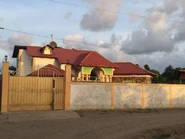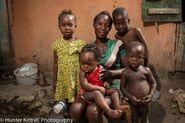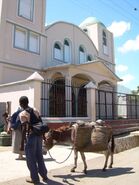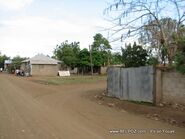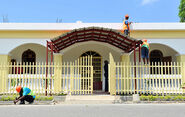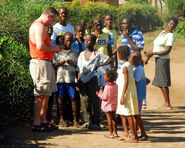"Men anpil, chay pa lou."
Many hands [make] the load lighter.
-Haitian proverb
Public transportation vehicles, Terrier Rouge, NE, Haiti
Terrier-Rouge (Haitian Creole: Tèrye Wouj) (English: Red Land) is a commune located in the Nord-Est Department in Haiti in the Trou-du-Nord Arrondissement.
About[]
Terrier-Rouge, also known as the "City of Mechanical Garages", is a third order administrative division. This commune brings together two communal sections and two districts. Ville de Terrier Rouge, so called because of the color of its soil - very favorable to the cultivation of coffee - is not very large. With an area of 1.5 square kilometers (0.6 square miles), the urban section had a density of 10,165 inhabitants per square kilometer. The atmosphere is healthy and pleasant. The 2nd section, Grand Bassin, was previouisly part of the commune of Trou-du-Nord.
History[]
The village was placed 3 leagues from the sea, 2 leagues from the Trou, 4 from Fort-Liberté and 9 from the Cape. The Caracol Pier, where the food from this commune is loaded for the Cape at two points distant from each other by 360 toises (1/3 mile), is located in the bay of Caracol, which received from Columbus the name of Port of the Nativity (French: Port de la Nativité; Spanish: La Navidad). It is there that the Spanish city of PORT ROYAL was established, by Rodrigo Mexia, in 1503; and abandoned before 1606. The river of Terrier-Rouge is also called La Matrie; it often shows only a dry bed.
Of note is the former military post of Jacquezy Pier.

Location in Haiti

Back road scene, Terrier Rouge
Geography[]
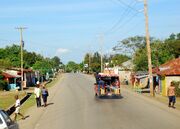
Main Street, Terrier Rouge
Terrier-Rouge is located at 19.6353° N, 71.9564° W. According to the IHSI, this commune has a total land area of 171.22 square kilometers (66.11 square miles), of which 167.88 km2 (98%) is suburban and rural and 3.34 km2 (2%) is urban. Terrier-Rouge is occupied mildly by around 161 people per square km. It is located 12km (7 mi.) west of Fort-Liberté and 36km (22 mi.) from Cap-Haïtien. It is bounded on the north by the Atlantic Ocean, on the south by the town of Perches, to the east by the city of Fort-Liberté and to the west by the city of Trou-du-Nord. It includes two communal sections: Fond-Blanc and Grand-Basin. The commune of Terrier-Rouge is presented as a triangle having the coastline as its base and Grand-Basin as its summit. It is an interior commune, consisting primarily of plains (it is 75% flat). The capital city of Haiti, Port-au-Prince, is located at a distance of 270km (170 miles) or 72 leagues.
Demography
The inhabitants are called Terrougeais/e or Terrier-Rougien/nne.
| Year | Population | +/- |
|---|---|---|
| 1890 | 8,000 | |
| 1998 | 16,623 | +108% |
| 2003 | 21,328 | +28% |
| 2009 | 21,577 | +1% |
| 2015 | 30,324 | +41% |
| TER | Terrier-Rouge | 30,324 | ||
|---|---|---|---|---|
| VTE | Ville de Terrier-Rouge | Urban | 15,248 | |
| QGS | Quartier de Grand Bassin | Urban | 9,207 | |
| FBC | 1re Section Fond-Blanc | Urban
Rural |
15,248
2,442 |
Berceca, Cormier, Duvray, Fond Blanc, La Hatte, La Porte, Nan Colline, Nan Perle, Paulette, Plantation Dauphin. |
| GBS | 2eme Section Grand Bassin | Rural | 3,427 | Bois Mouton, Bonne Fond, Bourgeois, Bricourt, Brousse, Chaber, Colonie Agricole de Grand Bassin, Conseil, Dos Rade, Gourde, Grand Bassin, Grande Savane, Gros Trou, Michel, Nan Régis, Petit Bourg de Danda, Roman, Sacristin, Savanette, Terou, Tibo, Toreste. |
| VIP | Ville Industrielle de Paulette | |||
| VPH | Ville Industrielle de Phaeton |
Climate[]
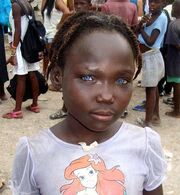
Young girl from Terrier Rouge
The municipality of Terrier-Rouge receives an average annual rainfall of 885 mm (35 in) in the section of Fond-Blanc and 1000 mm (39 in.) in the wetter section of Grand Bassin. Grand-Bassin has the highest altitude in town and better vegetation cover than Fond-Blanc. In general, Terrier-Rouge is wet from September to December; from April to June, it is rather dry. The rainy season is highly unstable, with the town experiencing drought lasting up to 8 months. The average temperature is oscillates around 29°C (84°F). The coldest month is February avg 16°C (61°F) and the warmest is July avg 32°C (90°F).
Natural resources[]
Soils
Two very distinct types of soils are found at Terrier-Rouge: in the Grand-Bassin area, they are of sandy-clay texture, rich in organic matter and with a good agricultural potential. But in the lower part, on the Fond-Blanc side, they have a limo-clay texture. These soils come from decomposition of diorites and basalt.
Water
The municipality of Terrier-Rouge does not have a large hydrographic network. There is a diversion from the Marion River in the Grand-Bassin section, and, in dry weather, it has such a low flow rate that one can not consider feeding an irrigation system from this water point. Paradoxically, Terrier-Rouge does has large groundwater reserves that allowed the construction of six hill lakes in the Fond-Blanc section to compensate for the lack of water.
Forest Resources

Sisal Farming. Terrier Rouge
The tree layer found in a part of the Fond-Blanc section, especially in the village of Terrier-Rouge, consists of interesting fruit species: avocados, mango, citrus, etc., and some forest species: eucalyptus, oak, mahogany.
The shrub layer in the areas of Paulette, Phaéton and Savane Carrée, is composed mainly of eucalyptus, bayahonde, candelabra and herbs that effectively protect the soil against erosion.
The lowlands of the Grand-Bassin section, which are generally rich and of excellent diversity, are the most wooded and humid areas.
Mines and quarries
The municipality of Terrier-Rouge is fairly well equipped in this area. There there would be granodiorite in Grand Bassin, Douvray and Blondin. The Grand-Bassin ore, gray and speckled, is similar to industrial granite, covering a surface area of about 4.5 acres. All deposits cover an area of about 14 acres. As for copper, its presence was localized in Douvray and Blondin, about 6 km southeast of Terrier-Rouge. These are polymetallic deposits of "porphyry copper" type. The Douvray deposit covers an area of 80 acres, with a potential of 86,000,000 tons with an average grade of 0.53% copper. That of Blondin, located about 1 km east of Douvray, extends on 22 acres and can provide 50,000,000 tons of 0.5% copper.
Of note is a quarry of white rocks and white earth in the area of Paulette.
Economy[]
Economical activities in Terrier-Rouge are summarized as agriculture, livestock, fishing and trade. Copper mines which began to be exploited in the early days of the Spanish colony are situated on the Roux des Isles or Champaing habitation. Other activities include large timber operations, cotton, poultry, and large and small cattle. The Rouvray habitation, which had belonged to the Jesuits, is the first place where coffee seeds were planted, which the Jesuits from Martinique sent to their brothers in Saint Domingue.
Agriculture
Although the establishment of the Dauphin company has, in the 40s, practically curbed subsistence farming for the benefit of industrial agriculture (intensive and exclusive planting sisal and rubber, systematic destruction of fruit trees, forest species and food crop), agriculture is still the main activity of this commune. In the section of Grand-Bassin, planters practice growing in association: beans, pigeon peas, peas unknown, peanuts, cassava, banana, rice, and both mountain and plain. Avocado and orange are among the most common fruit trees. These products are flowing well and farmers generate enough income to consider them as cash crops.
The section of Fond-Blanc is practically divided into two zones of cultures: the side adjoining the village of Terrier-Rouge, reserved for fruit trees (mango, avocado, and highly marketable orange trees), and the other part including Paulette, Phaéton and Dérac, where industrial agriculture is developing and the exploitation of bayahonde exists for the production of coal. In general, the products are sold to markets in the center of Terrier-Rouge, the neighboring communes of Perches, Trou-du-Nord, and Limonade, and along the roads.
Livestock
It remains a complementary and safe economic contribution for Terrier-Rouge growers. They all have a goat or oxen that they do not raise in managed pastures, but freely on their farms. Very often, old sisal plantations take the place of grazing pastures. Cattle, goats, horses, pigs and poultry make up the bulk of their livestock. The breeders face many difficulties related to: lack of food (fodder) and water for their animals, lack of veterinary care, lack of training and ignorance of available improved methods of breeding.
Fishing
It is also practiced on the coast of Paulette and in the hill lakes, but it has multiple constraints so that it yields less than the previous two activities to those who indulge in it.
Trade
After agriculture and livestock, commerce occupies a large part of the population. It is the privileged sector of women. Monday, market day, the flow of people from all over the commune and neighboring communities is impressive. No less impressive is the volume of agricultural products, also from the commune and its surroundings, including increased essential items, building materials, crates, and cereals from Santo Domingo.
The development of this sector is also strongly affected by the state of the roadways. The delivery of food is more or less difficult depending on the period. But, despite everything, trade remains vital to the local economy and to the survival of some families who find income supplement often low, but useful.
Secondary sector
The economic and financial infrastructure includes a hotel, four restaurants, a credit union and four marketing cooperatives. The impact of the secondary sector is not very significant in the economic life of the municipality. Only a few peanut mills (also cassava and maize) and a rice mill was found in the section of Fond-Blanc. In addition, there are bakeries, small grocery stores, hairdressers, small restaurants, borlette (lottery) stands, as well as a funeral home, food vendors, shoe polishers, and mechanic garages who offer their service informally to the population.
Five building materials shops, seven food supply centers, a dozen depots, three pharmacies and three photography studios form the commercial and economic establishments of the municipality.
Buildings and Infrastructure[]
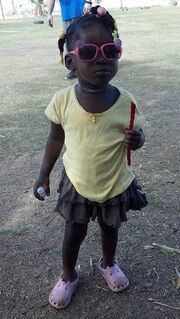
Little young lady with some attitude; Terrier-Rouge, NE, Haiti

Some Terrier Rouge homes
Mud and clay is used to construct homes. L'Ecole St and Clinique Esperence et Vie are among the few modern buildings in Terrier-Rouge. Few secondary and elementary schools are found here.
Road network
The lamentable state of its road network hampers the development of the municipality. This lack of road infrastructure has a negative impact on almost every other sector. At the level of agriculture, for example, the production areas remain isolated compared to the main sales centers like Perches, Trou-du-Nord, Limonade, and Ouanaminthe. With regard to health and education, the difficulty of circulating from one point to the other of the town also causes serious trouble. Needless to point out how much this situation stifles any attempt to implement tourism development in this municipality.
Education
Thirty or so schools, including three national schools, provide Terrier-Rouge's basic education. Several localities have a national school. The town also has 9 secondary schools, including a high school and an agricultural vocational school.
Health

Bethesda Medical Center; Grand-Bassin, Terrier-Rouge, Haiti
The population of the municipality of Terrier-Rouge is served by two community health centers with beds (one in Grand Bassin and one in the town center) and two communitiy health centers without beds, two clinics, and a dispensary in Phaeton. The 111-person medical staff consists of 20 doctors, 37 matrons, 15 nurses and 13 auxiliaries. Grand Bassin is home to the best-equipped medical center in the Northeast Department, which even offers quality odontology service. In addition, at fixed points or at community meetings, a nurse from The HOPE Foundation provides vaccination, weighing, and pre/post natal care.
Utilities
Terrier-Rouge has 9 rivers, 10 springs, 5 lakes, and dozens of wells and public fountains with pumps. Only the urban section is electrified, with a feeding frequency of 28 hours on average per week.
Access to drinking water
Formerly, the section of Fond-Blanc was supplied with water by an adduction system which became inoperative due to lack of regular maintenance. The population supplies itself therefore from hand pumps or by resorting to the services of individuals. At Grand-Basin, water sources are used; water is also captured, stored in cisterns and still dispensed by means of hand pumps. But these are very precarious installations and the problem of water is posed in terms of quantity and quality.
Many recurrent diseases originate from the absorption of contaminated water. Access to water by the bulk of the population remains a major problem; some see themselves indeed forced to travel for miles to collect the amount necessary for everyday use.
Waste management
Waste service does not exist because the municipal council (due to a lack of financial resources and logistical means) can not ensure the operation. Thus garbage collection is not ensured; the town center every day becomes more like a dumping ground, especially around points of sale and public places. It is unfortunate that the main public market serves as a rubbish dump site, as well as drainage canals, empty lots and streets. The decomposition of these filths releases odors and dangerous toxins that are detrimental to the population and the environment.
Security
The commune of Terrier-Rouge has two police stations, two peace courts and a civil status office. The town garrison is made up of a gendarmerie company, an administrative police, an artillery from Trou, the national guard on foot and on horseback, and the rural police.
Public institutions
The State is represented at Terrier-Rouge by some decentralized institutions: MSPP, MARNDR, SNEP, EDH, DGI, PNH. All, or most, face logistical and financial problems. Some do not offer any services; others intervene only within the rather limited opportunities that they are given to act. Services as important as those of the post office or a slaughterhouse are nonexistent.
Culture[]

Eglise Catholique a Terrier Rouge
Religion
Nearly 28 churches were counted in the commune. The number of Baptist churches is proving to be the highest, twelve in total, but the leading denomination of the region is Catholicism. Protestants and some others who practice various rituals and voodoo are also found. The patronal feast is on June 29, at Saint Peter's Day.
Organizations
Four NGOs operate in Terrier-Rouge; Plan International, Caritas, Protos-Haiti, and Hope. They work in various fields such as training, agriculture, education and health.
An NGO called His Hands for Haiti supports Terrier-Rouge children. The L'eglise Baptiste de Terrier Rouge Parish oversees the children, the large number of people and the NGO.
The commune also has three representations of political parties, seven popular organizations, and three peasant groups.
Communication
This commune contains a telephone office with two cabins, a post office and two radio stations.
Leisure

Terrier-Rouge Library, constructed 2013
The town of Terrier-Rouge has a library, a theater, three nightclubs, and five spaces for playing sports. Football (soccer), volleyball and basketball, are the most popular sports that are practiced. Additionally, there are two public squares, fifteen gaguères, and 22 peristyles.
For monuments and sites, the municipality has mostly natural sites, some of which are not easy to access since the channels of communication in some parts of town are largely lacking.
Tourism
Among its natural resources, the municipality of Terrier-Rouge offers various sites with potential for appeal. Visitors would appreciate the exceptional panoramic view offered by the Deux Mamelles in Paulette, and the Morne Gros-Louis. On the Grand-Bassin side is the beach from Four la Chaux to Phaeton and many historical sites evoking the colonial era in Duray, Nappe, Goud, Bon Fon, Bouton and Maurice.
References[]
Terrier Rouge [1]
FENAMH - Terrier Rouge [2]
Michael Vedrine



